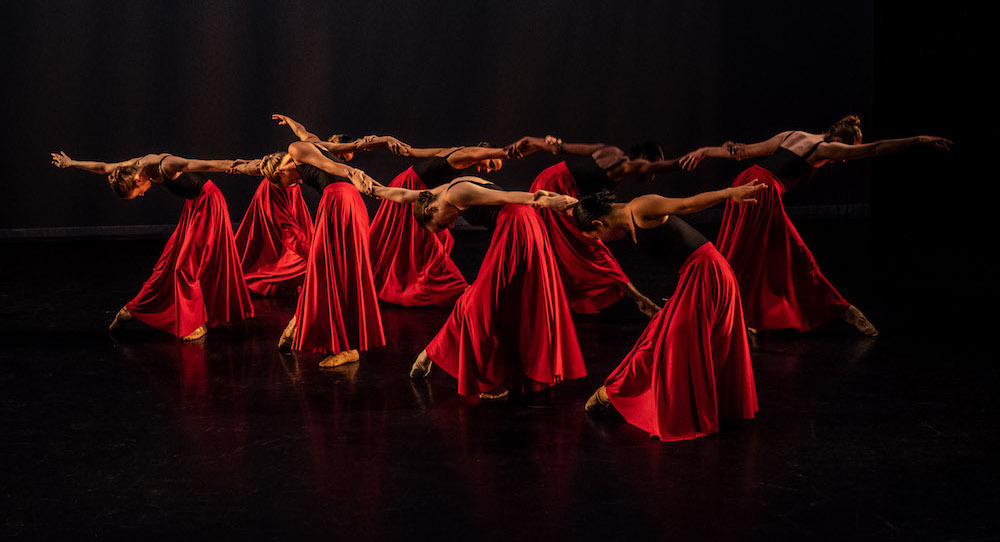The Ailey Citigroup Theater, New York, New York.
June 7, 2018.
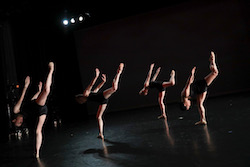
Lydia Johnson Dance in ‘Undercurrent’. Photo by Travis Magee.
Some of the dances I most clearly remember and commend are those that built a sensory world that could pull me right in. In all of these movement, staging, costumes, lighting, and music came together to create something not quite like anything I’ve ever seen before.
Lydia Johnson Dance accomplished this type of unique, captivating “world-building” in several works on its mixed-bill New York Season 2018. Lydia Johnson choreographed all works, with a signature style of wonderfully imbuing intuitive movement into the technical, stirring ease into the shaped and perfected.
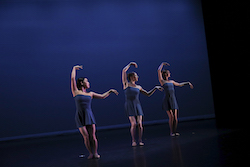
MinSeon Kim, Laura Di Orio and Katie Martin-Lohiya in Lydia Johnson Dance’s ‘What Counts’. Photo by Travis Magee.
Opening the night was What Counts (2015), with music from The Bad Plus and danced by an ensemble of five dancers. Lilting, sweeping extensions and partnering complimented easy, atmospheric jazz music. Attitudes moved through a bent knee, rather than caught in the shape. Partnering in sloping diagonal lines added a clean organization to the movement. Lighting was low, in a blue hue, with light blue costumes. The world being built was one of a jazz club late at night, inhibitions down and connections authentic. Lights came down, and I was still caught in that world of easy jazz, low lighting and smooth movement.
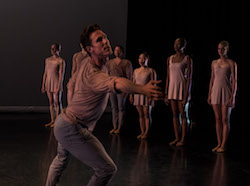
Stephen Hanna in Lydia Johnson Dance’s ‘This, and my heart beside…’. Photo by Dmitry Beryozkin.
This, and my heart beside (2017) came second in the program. The title comes from an Emily Dickinson poem, which was printed in the program. The poem gives a sense of a love so deep that the heart can’t fully hold it. Johnson had a very compelling way of conveying this in movement – with a sense of unity yet one with just the slightest distance, such as through bent knees in lifts (held away from the lifter) and unison phrases performed together with separation in space.
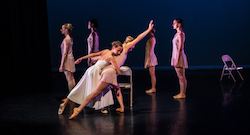
Katie Martin-Lohiya, Sara Spangler with Company in ‘This, and my heart beside…’. Photo by Dmitry Beryozkin.
One captivating repeated phrase was a torso roll with bent elbows into a fourth position layout (arms in parallel fourth position and the torso at forty five degrees, with a tendu derriere). Another striking section was with dancer Katie Martin-Lohiya and a young dancer, Sara Spangler. Although their exact relationship might be something to probe and clarify in (potential) future iterations of the work, back-and-forth movement of embrace and release was quite emotionally stirring.
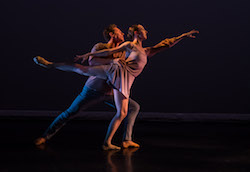
Stephen Hanna and Dona Wiley in Lydia Johnson Dance’s ‘This, and my heart beside…’. Photo by Dmitry Beryozkin.
Something about both these sections, as well as others, captured the groundedness and strength yet vague unease in Dickinson’s poem. The music of Marc Mellits and Philip Glass, with a barely noticeable atonal undercurrent, contributed to this feeling. Costumes also seemed to be paying homage to Dickinson.
What I wanted more of was a faster, more virtuosic section. It pulled me in and left me wanting more after it ended (what felt like all too soon). Also, perhaps intended, but in one section, two groups were far enough apart on stage that it was difficult to observe the movement of both at the same. All in all, however, the piece had wonderful movement danced by wonderful dancers, and supporting aesthetic elements to truly build its own compelling world.
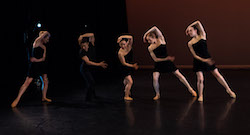
Lydia Johnson Dance in ‘Trio Sonatas’. Photo by Dmitry Beryozkin.
Trio Sonatas (2017) came third in the program. It made me think of the idea that a dancer’s instrument is her or her very body. Movement put the nuances of the movement in physical form, and the dancers seemed to have their whole selves in the movement. Certain repeated phrases demonstrated the inventive quality of Johnson’s phrasework – for instance, one where dancers folded the arms in from arms held in a parallel fourth, first bending the elbow of the arm overhead and that hand dropping down, then the other forearm folding into the abdominals. Intriguing horizontal lifts also demonstrated this inventiveness. Classic elegance, with modernized ingenuity, was the dominant feel.
The premiere of Undercurrent closed the show. In a way, it felt like it could have been two different pieces, both compelling and accomplished in their own right. Music from Henryk Górecki and the Warsaw Philharmonic Orchestra, combined with footwork referencing old-fashioned ballroom dance, had the piece feeling like an echo of a chamber dance.
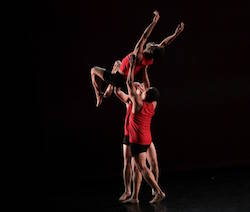
Peter Cheng held aloft by Chazz Fenner-McBride and Daniel Pigliavento in ‘Undercurrent’. Photo by Dmitry Beryozkin.
More contemporary movement, such as partnering with folding and opening (the pair doing so together), brought the movement into the modern day – with that chamber dance aesthetic remaining strong. Other movement with this kind of contemporary feel was a lovely moment of dancers rising through the spine in a wave in cannon, in the feel of those sports game “waves” (although far more refined).
The music quickly changed, to something much faster and brighter-feeling. The costumes also changed to add on large red skirts to the all-black that were already there. The lighting also brightened. Younger dancers, youth of varied ages and sizes, joined to create a large ensemble. The main company soon exited, and the younger dancers took the stage to themselves. Their movement echoed folk dance, with pared-down steps in lines. The sensory world created, and energy of many moving bodies onstage, was the main offering here – and a very valid, enjoyable one it was.
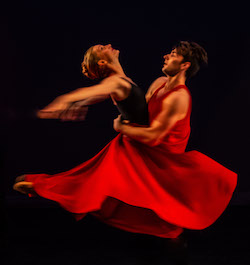
Katie Martin-Lohiya and Daniel Pigliavento in Lydia Johnson Dance’s ‘Undercurrent’. Photo by Dmitry Beryozkin.
The main company re-joined, and all joined in these simple, yet refined ballroom steps in lines echoing folk dance. This movement, along with red skirts, black tops and a red-hued cyc (backdrop) made a powerful visual impression. The music added another sensory layer to make something quite beautiful and memorable. A powerful ending topped all of this off with a bright cherry; Laura Di Orio was raised high, in a lovely double attitude while lying horizontally, above all other dancers in clean lines reaching up high.
I did wonder about these two atmospherically, qualitatively sections coming together as one. Perhaps a clearer intent for that can be ironed in further iterations in the work. It’s certainly something to remember that this is a premiere. That aside, as was the case with the prior three works in the program, the atmospheric world here was what felt more memorable – as well as something to be commended. I look forward to seeing more from this company, perhaps even these works again, as they further these strengths and iron out these areas to be developed. Art is a living, breathing thing to be massaged and molded, as well as to be brought into and fully experienced.
By Kathryn Boland of Dance Informa.


